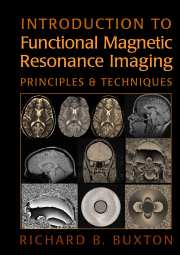6 - Imaging Functional Activity
from IB - Introduction to Functional Magnetic Resonance Imaging
Published online by Cambridge University Press: 05 September 2013
Summary
MR EFFECTS OF BRAIN ACTIVATION
In Chapter 3 the basic physiological changes accompanying brain activation were described. Cerebral blood flow (CBF) increases dramatically, and the metabolic rate of oxygen consumption increases by a smaller amount. As a result, the oxygen content of the capillary and venous blood is increased. In addition, the blood volume and blood velocity increase. With this picture of brain activation in mind, what are the possible observable effects these physiological changes might have on the magnetic resonance signal that could form the basis for measuring activation with magnetic resonance imaging?
The first potential effect is due to increased velocity of the blood. By applying bipolar gradient pulses, the intrinsic flow sensitivity of the magnetic resonance (MR) signal can be exploited. Individual capillaries cannot be resolved, so the flow effect is more analogous to diffusion imaging than to MR angiography. An early conceptual model for functional imaging is to imagine that a capillary bed consists of randomly oriented cylinders. Then the uniform motion of the blood, but in random directions, is similar to the random walk of freely diffusing water molecules (LeBihan et al., 1988). The effect on the MR signal of this IntraVoxel Incoherent Motion (IVIM) is qualitatively similar to the effect of diffusion: when a bipolar gradient is applied, the signal is reduced because the spins move during the interval between the two lobes of the gradient pulse so that refocusing is incomplete. Quantitatively, the IVIM effect is much larger than diffusion because the spins are carried farther by capillary flow than by diffusional motions.
If the bipolar gradient pulse is sufficiently strong so that the signal from moving blood is completely destroyed, rather than just attenuated, the blood volume can be measured by subtracting the signals measured with and without diffusion weighting.
Information
- Type
- Chapter
- Information
- Introduction to Functional Magnetic Resonance ImagingPrinciples and Techniques, pp. 104 - 120Publisher: Cambridge University PressPrint publication year: 2002
